History
Carballo is relatively new when compared to other towns in the region. Its origins go back to the rediscovery of the hot springs in 1716. They had in fact been previously used, as evidenced in the excavation work carried out by the architect Miguel Ferro Caaveiro in 1777, which brought to light remains of what were ancient baths, possibly of Roman origin.
The parish of San Xoán de Carballo was here before the town of Carballo was established. The parish was created in the Middle Ages on the left bank of the Anllóns, in Cernide, where the old parish church was located. The first records of Carballo date back to the mid-15th c., when it was under the control of the monastery of San Pedro in Soandres (A Laracha).
When the medicinal waters on the right bank of the river near the hamlet of A Lagoa were rediscovered, building work commenced on the first houses to offer accommodation to the bathers who came to enjoy the springs. And so, the town of Carballos was born.
When the spa was rebuilt in the mid-19th c., Carballo was already a town with two small districts: one that surrounded the baths, may of which were built to provide lodging for bathers, and another further south on the crossroads that went through the town, where the market and fair were held. The residents of this new district were mostly businessmen and civil servants working in the offices of the new judicial district of Carballo.
By the 1920s, Carballo was a modern town, with a well designed layout and a busy commercial, social and cultural life. The town extended along the two roads that crossed it from north to south (Coruña-Fisterra) and east to west (Santiago-Malpica). The 1920s saw the construction of the Praza do Mercado, in the area of the new Town Hall. At the same time the Desiderio Varela school and the new pavilions for the market and fair were also built.
Political and trade union activities intensified during the 2nd Republic, which was stamped out after the military rebellion of 1936, when political and trade union leaders were hunted down and shot or imprisoned.
Carballo experienced wolfram fever in the late 1930s and 1940s. The mine at Monte Name was nearby and wolfram became a highly valuable mineral in World War II. Besides the workers employed by the mining company, many others trespassed on the mountain to try and find chunks of wolfram and sell them on the black market to make some much-needed money.
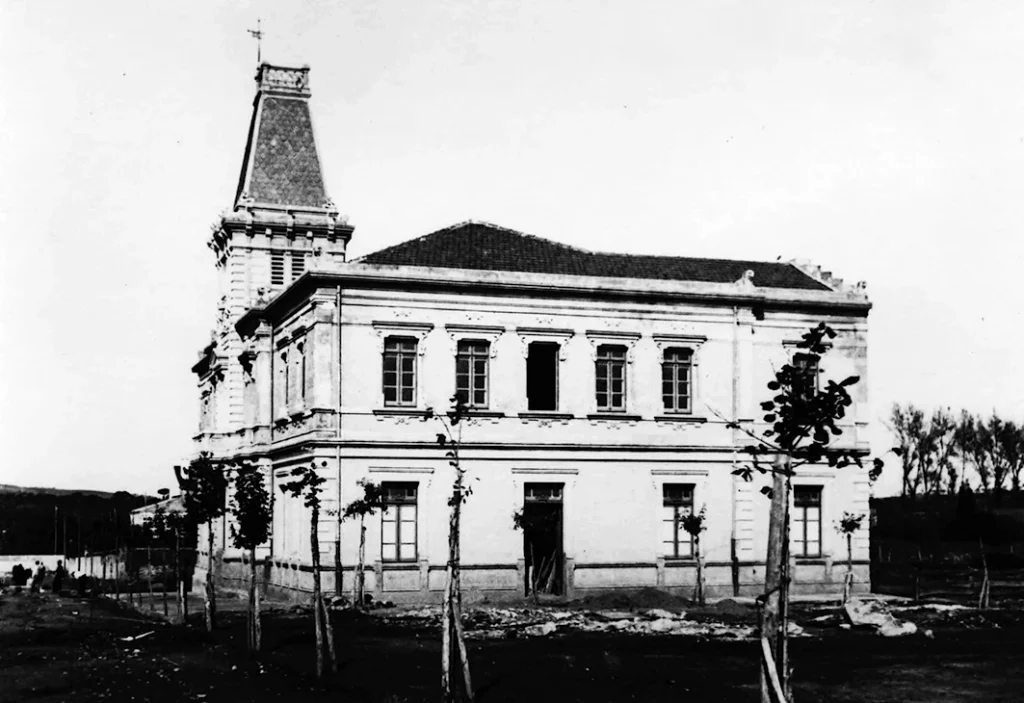
The Conservas Calvo factory opened in the 1940s. The factory, which was first located in the town centre and then transferred to A Revolta, gave a lot of work to local residents.
Another major event in the town’s history was the inauguration of the trolleybus line from Carballo to A Coruña in 1950, which improved connections between the town and the city.
Urban speculation in the 1960s and 1970s did a great deal of damage to the historical centre of the town. Buildings of great architectural and historical value such as the parish church, the town hall and the spa at the Baños Vellos were lost forever.
The Carballo that you see today is the outcome of planning and construction carried out in the late 20th and early 21st centuries: new streets were opened, the roads in the town centre were pedestrianised, the banks of the rive Anllóns were recovered and new public buildings were built, such as the Pazo da Cultura, the Forum and the new library. The recent transformation undergone by the town has created a new Carballo with an active economy, and a vibrant cultural and sporting life, a town that faces the future with optimism.
Route on foot around the town
The route we propose for you to discover the town on foot starts at the Museum of Bergantiños, in the building that was the old prison and built in 1855. It was rehabilitated by the architect Manuel Gallego Jorreto. The building also contains the tourist information office.
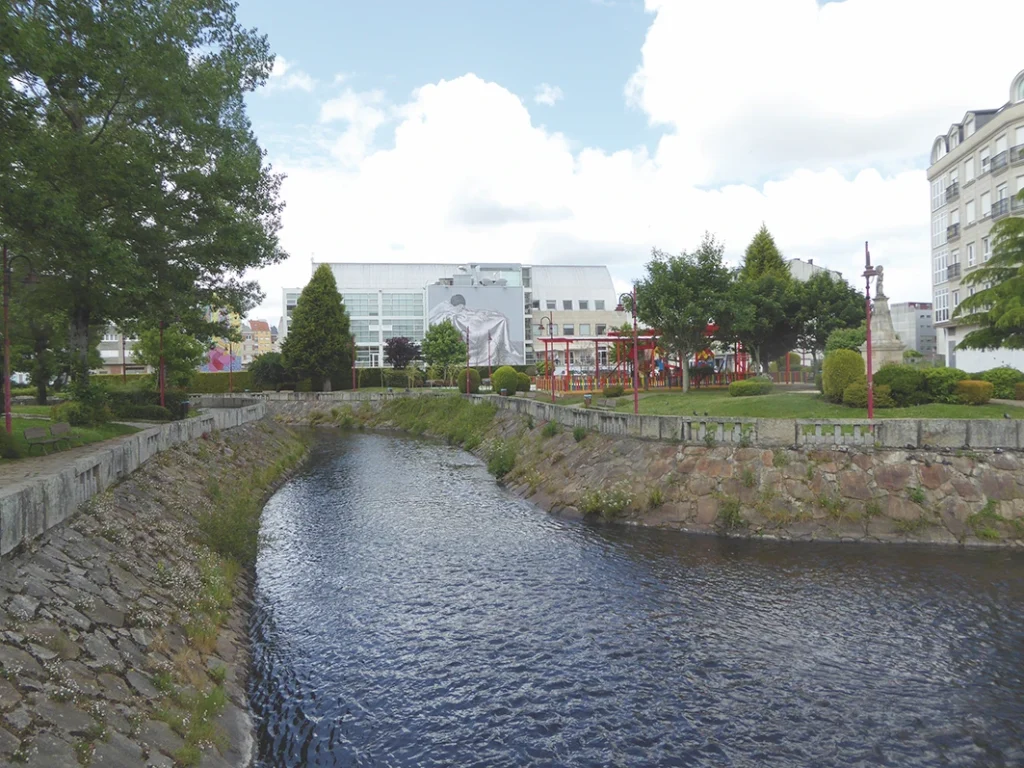
The museum was opened in 2002 and has several exhibition spaces with displays on the history and culture of the region of Bergantiños and Carballo itself. Another exhibition space about Costa da Morte was opened in 2007. Twenty years after the museum opened its doors, rehabilitation work was completed in the entire exhibition area and a new space was inaugurated in December 2022 for an exhibition on the archaeology of office machinery (typewriters, calculators, printers, copying machines, telephones, computers, etc.). The municipal library is right next to the museum.
Leave the museum and turn left. You’ll pass by the parish church of San Xoán Bautista. The church you see today is the third one to be built here. The first one, built in 1864, was designed by the architect Faustino Domínguez in the late classicist style. Problems caused by poor construction techniques and building materials soon started to appear and the church was closed in 1890. Another church in the Rúa San Xosé was used as a temporary substitute until 1924, when the new church building was opened. Designed in the neo-medieval style by the architect Manuel Hernández y Álvarez Reyero, this church also had problems due to poor planning, since the building was left without a roof for many years, which contributed to its deterioration.
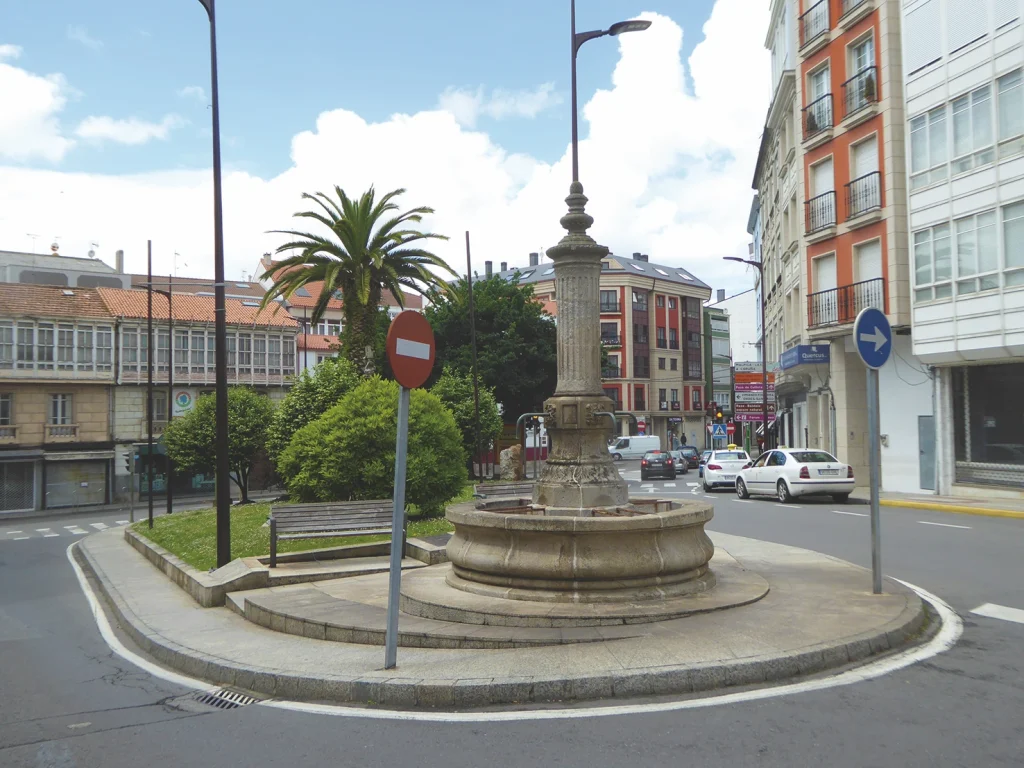
The decision was made to build another church and demolish the previous one in 1974 although it could have been restored because the stone used to build was of good quality. The design for this third church was drawn up by the local architect José Manuel Rey Pichel. In place of a church, a parish complex was built entirely of concrete with several rooms and halls. The bells, some images and liturgical objects from the previous church were used. In the atrium you can see a calvary of 1811, which was transferred from Cernide, home of the old parish.
From the parish church head to the Praza de Galicia, previously called Praza da Liberdade, which is an intersection of several streets and the centre of old Carballo. The fair and market are held here. Three residences in the centre of the plaza were expropriated in the 1920s and replaced by a garden. A four spouted fountain was built on the east side in 1890 when the town was first provided with a water supply. The fountain can still be seen today. The calvary in the green space was placed there in 1982, in homage to Alfredo Brañas. It is a work by Manuel García Vázquez. A few 19th and early 20th c. stone built houses with balconies and galleries can still be seen in the plaza.
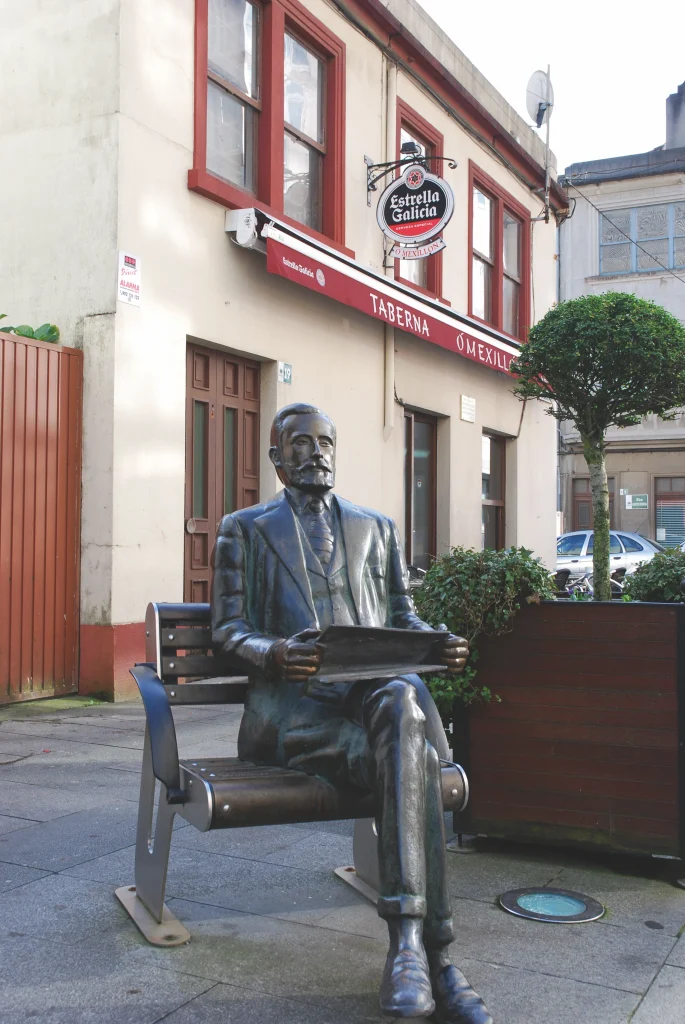
Head back from the Plaza de Galicia along the Rúa Coruña, which was opened in 1954 to connect the Rúa Martín Herrera to the Praza do Mercado. As you enter, in the right hand corner you’ll see the childhood home of Alfredo Brañas Menéndez, a famous jurist and regional politician, who was born here on 11 January 1859. His home town has paid him several tributes: in 2005 a statue of of Brañas, sculpted by César Lombera was placed next to the house where he was born.
Walk along the Rúa Coruña, a street with shops, bars and restaurants, until you come to the Praza do Mercado, the broadest and most central public space in the town. The plaza was built during the urban rehabilitation of the nineteen twenties and was where the market and fair were to be held.
The only building in this plaza was the old Town Hall, designed by the architect Julio Galán and opened in 1913. The clock tower was added in 1943. The modernist style of the building was typical of the period. It was demolished when the new town hall was built in the opposite corner to the previous one. The new building was designed by the local architect José Manuel Rey Pichel and inaugurated in February 1974. The new town hall consists of a series of rectangular volumes whose surfaces shrink from the ground upwards, with a strong emphasis on horizontal lines.
The municipal market can be seen to the east of the town hall, and replaces the old pavilions built in 1929. The market was designed by the architect Ramón Tenreiro Brochón and opened to the public in 1969.
A number of defects and limitations led the municipal government to carry out a complete restoration of the entire structure to adapt it to the present day. The new market was opened in 2010.
The same plaza is also home to the building of the Escolas do Xardín school, built in 1929 with funding from doctor Desiderio Varela Puga, whose only condition was the façade should include a plaque in memory of his wife Amalia Gómez Rodríguez. It consists of two lateral buildings with a stairway on each side and a central building that is set further back. Each stairway gave access to the boys’ or girls’ section of the school. Many generations of local children studied here.
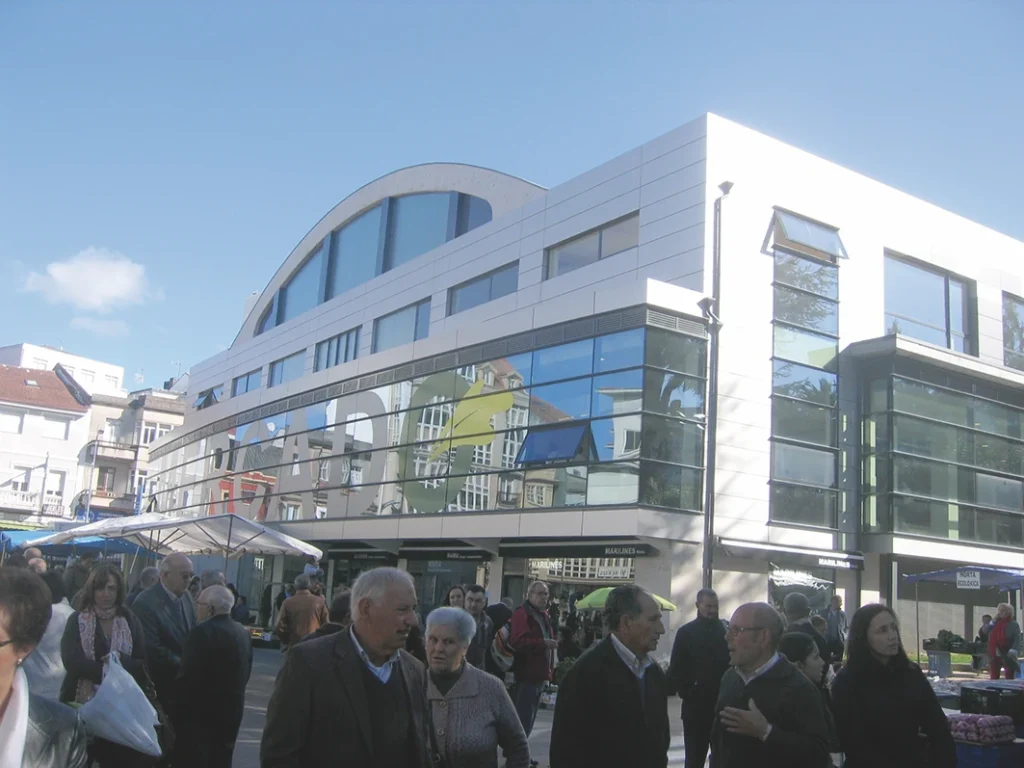
Leave the plaza and continue westwards along the Rúa Desiderio Varela. The Casino can be seen in the Rúa Vázquez de Parga. This leisure association was founded in 1889, and was transferred in the 1920s to the building it occupies today in the Rúa Lugo. The association was later called the Sociedad Cultural y Recreativa Bergantiños. It was the main cultural and social centre of the town for many years, especially at certain times like Christmas, Carnival or Midsummer Night. The association’s facilities were rehabilitated on several occasions. Perhaps the most notable changes were in the 1950s when Julio Sánchez was chairman, when the largest room was converted into a richly decorated salon that can still be seen. The association is now managed by a group of young directors and and has a highly dynamic cultural and social agenda.
Leave the Casino and head towards the Rúa da Estrela, named after the chapel dedicated to the Virxe da Estrela (Virgin of the Star) that used to be next to the spa. Walk towards the spa called Baños Vellos. The name contrasts with the Baños Novos, which were discovered later.
The origins of the baths of Carballo may go back to the Romans, according to a report by the architect Miguel Ferro Caaveiro, after excavations carried out in 1777 because of a court case over the ownership of the baths.
Estas aguas termales fueron redescubiertas en 1716, pasando después a ser propiedad municipal. En 1851 las adquirió Pedro Sanjurjo, hijo del que había sido el primer médico director de los baños. El nuevo propietario reforma todo el edificio. Adosado a él por la parte sur, se situaba la capilla de la Virgen de la Estrella y por la parte norte, una casa de hospedaje y una fuente. Delante de todas estas construcciones había un espacio verde con árboles, que llegaba hasta la calle de A Braña (actual Vázquez de Parga).
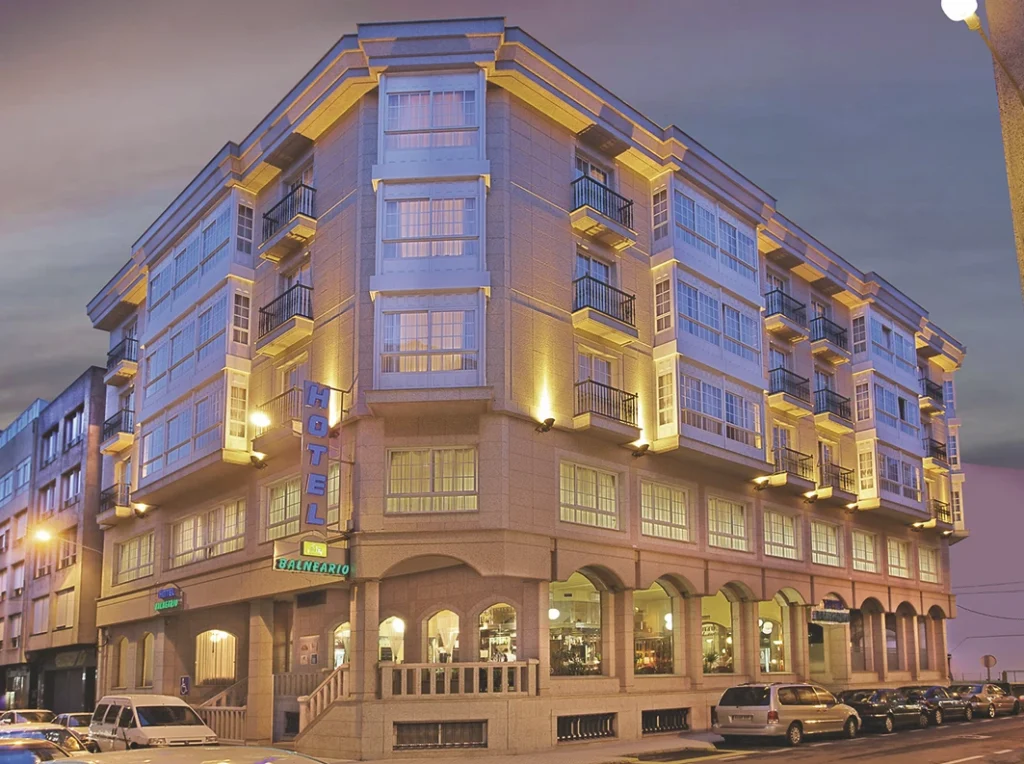
The baths at Carballo were regarded as the most popular in Galicia in the second half of the 19th and early 20th c.
After a period of decay in the 1970s, the baths and their surroundings were sold as plots of land, and then the new spa was built in 1985. The hotel was opened in 1994.
The spa waters are bicarbonated, rich in sodium and sulphur and currently flow at a temperature of 42 ºC. They are recommended for problems of the skin and the musculoskeletal, respiratory, digestive, nervous and circulatory systems.sistema nervioso y circulatorio.